Okay, fine, if your life points reach 0, you die. However, the main focus of the game is often to beat your opponent in terms of Card Advantage.
Card Advantage: A Definition
If you have more cards in hand/field than your opponent, you have more options than your opponent. This is the general premise of Card Advantage.
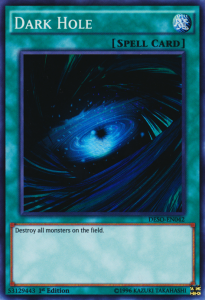
Cards can be viewed as resources which each serve a specific purpose for you in a game.
Sometimes, you want to get rid of an opponent's monster. This is where Dark Hole is useful. Sometimes you want to stop your opponent from setting up a board of monsters. This is where Solemn Strike is useful. Sometimes, you want to stop your opponent from having fun. This is where Ash Blossom & Joyous Spring is useful.
Each card is a tool which serves a purpose. If you have more cards in hand/field than your opponent, you have more tools than your opponent. This means that you have more options than your opponent, which will provide you with the most likely chance of success!
Examples of Card Advantage
Generally, we calculate card advantage by counting the number of cards in our hand/field compared the the amount of cards in your opponent's hand/field. If you have more then them, you're winning - in terms of card advantage at least!
Here are some simple examples of how the theory of card advantage can be applied to a game. Note that some people refer to card advantage as "card equity". These terms are completely synonymous with each other.
Upstart Goblin
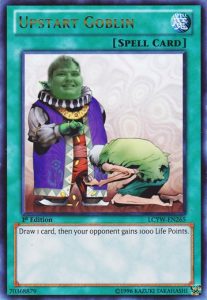 Upstart Goblin is a pretty simple card. You activate it, your opponent gains 1000 LP, and you draw a card. But how does it work out in terms of card advantage? Let's break it down:
Upstart Goblin is a pretty simple card. You activate it, your opponent gains 1000 LP, and you draw a card. But how does it work out in terms of card advantage? Let's break it down: - I have no cards in my hand/field, other than Upstart Goblin. Card Equity = 1
- I activate Upstart Goblin.
- My opponent gains 1000 LP, and I draw 1 card.
- Upstart Goblin is sent to the graveyard after resolving.
- I have no cards in my hand/field, other than the card I draw. Card Equity = 1
Before activating Upstart Goblin, my Card Equity was 1. This is because I had exactly 1 card available to me for use. After activating Upstart Goblin, my Card Equity was still 1. I use the Upstart, then I lose the Upstart but gain another card. Note that the life points gained here are completely irrelevant: When counting for card advantage, we only look at the cards in out hand/field, not any other type of resource.
We call this a "Plus Zero" in terms of card advantage, because using the Upstart Goblin didn't increase nor decrease the amount of cards available to me.
Pot of Greed
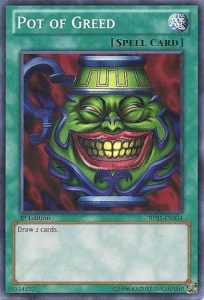 Here's a similar example. Many yugioh players don't know what Pot of Greed does, so I'll explain that quickly. You activate Pot of Greed, then you draw 2 cards from your deck, and then the Pot of Greed in sent to your Graveyard. Memes aside, what does this look like in terms of card advantage?
Here's a similar example. Many yugioh players don't know what Pot of Greed does, so I'll explain that quickly. You activate Pot of Greed, then you draw 2 cards from your deck, and then the Pot of Greed in sent to your Graveyard. Memes aside, what does this look like in terms of card advantage?- I have no cards in my hand or field, other than Pot of Greed. Card Equity = 1
- I activate Pot of Greed.
- I draw 2 cards from my deck.
- Pot of Greed is sent to the graveyard after resolving.
- I have no cards in my hand/field, other than the 2 cards I draw. Card Equity = 2
This is different to the Upstart Goblin example. After resolving the Pot of Greed, my Card Equity has increased! Before I only had 1 card, but now I have 2. I've increased the amount of cards in my hand/field by one, meaning that Pot of Greed is a "Plus One" in terms of card advantage!
Pot of Desires
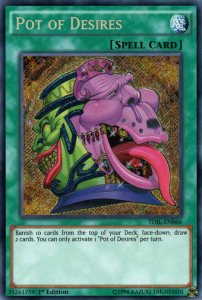 Pot of Desires is a card which a lot of new players trip up on. It's very similar to Pot of Greed, but with a slight difference: The cost of activating Pot of Desires is to banish the top 10 cards of your deck. Let's break down what the card does:
Pot of Desires is a card which a lot of new players trip up on. It's very similar to Pot of Greed, but with a slight difference: The cost of activating Pot of Desires is to banish the top 10 cards of your deck. Let's break down what the card does:- I have no cards in my hand or field, other than Pot of Desires. Card Equity = 1
- I activate Pot of Desires.
- Desires banishes ten cards from my deck.
- I draw 2 cards from my deck.
- Pot of Desires is sent to the graveyard after resolving.
- I have no cards in my hand/field, other than the 2 cards I draw. Card Equity = 2
Remember how I described card advantage earlier? "If you have more cards in hand/field than your opponent, you have more options than your opponent". Banishing ten cards from the deck with Pot of Desires doesn't affect the amount of cards in your hand or field. Before using desires, I had 1 card in my hand/field. After using it, I have 2 cards. This means that Pot of Desires is a "Plus One" in terms of card advantage.
Card Advantage isn't everything
In the previous example, we proved that Pot of Desires is exactly the same as Pot of Greed in terms of card advantage. Obviously, this isn't quite true: Pot of Desires has a cost attached to it, making it worse than Pot of Greed. So, what's up with this disconnect between the two? They're equal in terms of card advantage, after all!
The answer to this is seen in how card advantage isn't the be-all, end-all method of evaluating cards. It's just one way of comparing how good a card is when compared to another. Card advantage can be seen as a guideline when looking at cards, and really is very helpful for your card evaluation. Despite this, it doesn't consider everything.
Raw and Virtual Card Advantage
Before, I was really referring to raw card advantage. However, there are actually multiple different ways of interpreting card advantage - The main other one being virtual card advantage.
Essentially, Raw card advantage counts the number of cards in our hand/field.
Virtual card advantage only considers the amount of useful cards in our hand/field.
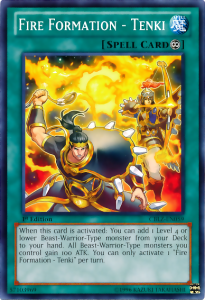
Let's look at Fire Formation - Tenki as an example.
- I have no cards in my hand or field, other than Tenki. Card Equity = 1
- I activate Tenki.
- I add Gene-Warped Warwolf from my deck to my hand.
- Fire Formation Tenki remains on the field after resolving.
- Card Equity = ?
In terms of Raw card advantage, We just went plus one! We started with just Tenki, but now we have both Tenki and our Warwolf!
However, Fire Formation - Tenki doesn't really do much once it's already on the field. Sure, we get a +100 ATK buff to all of our monsters, but it's not really relevant. Because of this, the card can be seen as useless after it's face-up on the field. Virtual card advantage only counts the number of useful cards that we have. As a result of it only being useful for one single purpose, Fire Formation - Tenki is often seen as a "Plus Zero" in terms of card advantage.
You should note that Fire Formation - Tenki can sometimes be a Plus One. After activating it, we might search for a Brotherhood of the Fire Fist - Bear. Bear's effect can pop our Tenki to destroy an opponent's monster. Since we started with just Tenki, but ended up with both a monster and removal of an opponent's monster, we've gone "Plus One" over our opponent in terms of card equity!
Recap
If you've gotten this far, that means that you now understand the most fundamental concept of strategic Yu-Gi-Oh! In this article, we covered:
- The definition of "Card Advantage"
- What "Plusses" are
- The difference between "Raw Card Advantage" and "Virtual Card Advantage"
- Contrasts between "Raw" and "Virtual" card advantage
Try evaluating the cards in your own deck - How many of them give you plusses? How many of them give you minuses?
Until next time - Stay Groovy!




